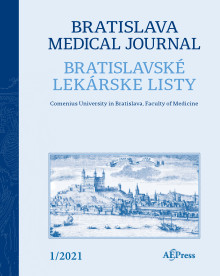Journal info
|
||||
Select Journal
Journals
Bratislava Medical Journal 2024 2023 2022 2021 2020 2019 2018 2017 2016 2015 2014 2013 2012 Ekologia - Ecology Endocrine Regulations General Physiology and Biophysics Neoplasma Acta Virologica Studia Psychologica Cardiology Letters Psychológia a patopsych. dieťaťa Kovove Materialy-Metallic Materials Slovenská hudba 2025Webshop Cart
Your Cart is currently empty.
Info: Your browser does not accept cookies. To put products into your cart and purchase them you need to enable cookies.
Bratislava Medical Journal Vol.123, No.6, p.449–454, 2022 |
||
| Title: A multimodal opioid-sparing pain management following total knee replacement | ||
| Author: Marek LACKO, Martin MATUSKA, Martin FOLVARSKY, Ahmad GHARAIBEH, Antonia LACKOVA, Peter POLAN, Radoslav ZAMBORSKY | ||
| Abstract: OBJECTIVE: The purpose of this study is to compare the pain scores, opioid consumption, and range of motion of the operated knee after total knee replacement (TKR) in the 10-day follow-up period between a traditional opioid-containing pain management protocol and a multimodal opioid-sparing treatment protocol. METHODS: This prospective, randomized, single-center study included 90 patients (24 men and 66 women; mean age 69.7±7.2 years) undergoing TKR for osteoarthritis between October 2019 and October 2020. Patients were randomized into 3 cohorts for comparison: traditional opioid-containing pain management protocol (n=30), multimodal opioid-sparing pain management protocol (n=30), and traditional opioid-containing pain management protocol with additional local infiltration analgesia (LIA). Changes in visual analog scale for pain (VAS), range of motion (ROM), and opioid consumption were compared between groups. RESULTS: A lower mean postoperative VAS score was observed in the opioid-sparing cohort, which was statistically significant at all time points compared with the traditional cohorts. Mean total morphine consumption was significantly lower in the opioid-sparing cohort (2.7±5.8 MMEs) compared to the traditional (14.0±14.8 MMEs) and traditional with LIA cohorts (8.3±9.5 MMEs; p<0.05). The mean degree of flexion of the operated knee of patients was significantly greater in patients in the opioid-sparing group than in the other groups on the postoperative day 3 (opioid-sparing: 87.0±11.2°; traditional: 74.1±11.6°; traditional with LIA: 84.7±8.9°; p<0.05), as well as on day 10 (opioid-sparing: 99.3±10.8°; traditional: 87.3±12.4°; traditional with LIA: 92.5±9.7°; p<0.05). The rate of adverse events after TKR did not differ between the groups. CONCLUSION: The results of this study suggest that a multimodal opioid-sparing pain protocol after TKR, which includes oral non-opioid medications and periarticular injection with bupivacaine, provides better pain relief and early functional gains with fewer rescue opioids compared to traditional opioid-based protocols (Tab. 4, Fig. 2, Ref. 22). |
||
| Keywords: total knee replacement, postoperative pain, pain management, opioid-sparing | ||
| Published online: 16-May-2022 | ||
| Year: 2022, Volume: 123, Issue: 6 | Page From: 449, Page To: 454 | |
| doi:10.4149/BLL_2022_070 |
||
|
|
 download file download file |
|

